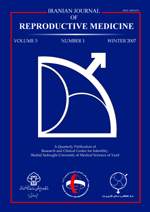
|
International Journal of Reproductive BioMedicine
Research and Clinical Center for Infertility, Shahid Sadoughi University of Medical Sciences of Yazd
ISSN: 1680-6433
EISSN: 1680-6433
Vol. 2, No. 1, 2004, pp. 15-20
|
 Bioline Code: rm04004
Bioline Code: rm04004
Full paper language: English
Document type: Research Article
Document available free of charge
|
|
|
International Journal of Reproductive BioMedicine, Vol. 2, No. 1, 2004, pp. 15-20
| en |
The Impact of Ovarian Stimulation and Luteal Phase Support on Embryo Quality and Implantation Process in Mice
Hashemitabar, Mahmoud; Ghavamizadeh, Babak; Javadnia, Fatemea & Sadain, Esmaiel
Abstract
Background:
The luteal phase defect is a common event following the ovarian stimulation. The aim of the present study was to evaluate the use of human chorionic gonadotropine (hCG) and progesterone hormones to improve the luteal phase defect.
Materials and Methods:
60 mice were superovulated routinely with human menopausal gonadotropin (hMG) (7.5U) and hCG (10U). The mice were mated and divided into 3 groups: 1- control (n=20) 2- hCG treatment (n= 20), and 3-Progesterone treatment (n=20). Each group was divided again into two subgroups. The mice (10 from each group) had no injection in group one and were injected intraperiteneal (IP) by hCG (5U/day) and progesterone (1mg/day) subcutaneously (sc) in groups 2 and 3, respectively for four days. On the day 5, the animals were killed by cervical dislocation and the uterus were flushed to count the number of blastocyst and their quality. The above treatment were carried out for 12 days in the other 10 mice in each group. Similarly group one had no injection and groups 2 and 3 were injected by hCG and progesterone for 12 days respectively by the same manner as mention above. The animals were killed on day 13 and the implanted embryos were counted. The uterus and ovary were processed on days 5 and 13 of pregnancy for histological studies.
Results:
The mean number of blastocysts per mouse were: 12.2%, 2.6% and 3% in group 1 to 3, respectively. The nomber of implanted embryos were 29 as: 13 living fetus in one mouse and 16 resorption fetus in the other. The morphology of uterus on day 5 was as follow: no development in the stroma and endometrial gland in control group, the stroma and endometrial gland so developed to form the saw teeth appearance which indicated on receptivity of uterus in hCG treated group similar to progesterone treated group, but without the saw teeth appearance. The continuation of hCG injection maintained the receptivity of uterus; while, the continuation in progesterone caused metaplesia of epithelium. The morphology of ovaries in all three groups showed no changes in corpus luteum size on day 5, and showed the following changes on day 13: increasing the number of primary and secondary follicles in control group; while, reducing the size of corpus luteum in hCG group.
Conclusion:
Progesterone did not improve the uterus and implantation rate. The prolonged usage of progesterone can change the morphology of uterus to more abnormal state in conterast to the prolonged usage of hCG.
Keywords
Implantation, Luteal Phase Defect,Ovarian Stimulation, Embryo, Mice
|
| |
© Copyright 2004 - Iranian Journal of Reproductive Medicine
Alternative site location: http://www.ijrm.ir
|
|
